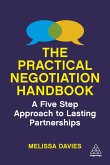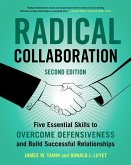27,99 €
inkl. MwSt.
Versandkostenfrei*
Liefertermin unbestimmt
Melden Sie sich
hier
hier
für den Produktalarm an, um über die Verfügbarkeit des Produkts informiert zu werden.
- Gebundenes Buch
Companies that consistently negotiate more valuable agreements in ways that protect key relationships enjoy an important but often overlooked competitive advantage. This book argues that negotiation must be a strategic core competency. It is suitable for CEOs, senior-level managers, HR business leaders, and human resource professionals.
Andere Kunden interessierten sich auch für
![Getting to Yes with Yourself Getting to Yes with Yourself]() William UryGetting to Yes with Yourself16,99 €
William UryGetting to Yes with Yourself16,99 €![Negotiation Negotiation]() Negotiation23,99 €
Negotiation23,99 €![Hbr's 10 Must Reads on Negotiation (with Bonus Article 15 Rules for Negotiating a Job Offer by Deepak Malhotra) Hbr's 10 Must Reads on Negotiation (with Bonus Article 15 Rules for Negotiating a Job Offer by Deepak Malhotra)]() Harvard Business ReviewHbr's 10 Must Reads on Negotiation (with Bonus Article 15 Rules for Negotiating a Job Offer by Deepak Malhotra)22,99 €
Harvard Business ReviewHbr's 10 Must Reads on Negotiation (with Bonus Article 15 Rules for Negotiating a Job Offer by Deepak Malhotra)22,99 €![The Practical Negotiation Handbook The Practical Negotiation Handbook]() Melissa DaviesThe Practical Negotiation Handbook29,99 €
Melissa DaviesThe Practical Negotiation Handbook29,99 €![HBR Guide to Negotiating HBR Guide to Negotiating]() Jeff WeissHBR Guide to Negotiating19,99 €
Jeff WeissHBR Guide to Negotiating19,99 €![Negotiating the Impossible Negotiating the Impossible]() Deepak MalhotraNegotiating the Impossible23,99 €
Deepak MalhotraNegotiating the Impossible23,99 €![Radical Collaboration Radical Collaboration]() James W. TammRadical Collaboration16,99 €
James W. TammRadical Collaboration16,99 €-
-
-
Companies that consistently negotiate more valuable agreements in ways that protect key relationships enjoy an important but often overlooked competitive advantage. This book argues that negotiation must be a strategic core competency. It is suitable for CEOs, senior-level managers, HR business leaders, and human resource professionals.
Hinweis: Dieser Artikel kann nur an eine deutsche Lieferadresse ausgeliefert werden.
Hinweis: Dieser Artikel kann nur an eine deutsche Lieferadresse ausgeliefert werden.
Produktdetails
- Produktdetails
- Verlag: Harvard Business School Press / McGraw-Hill Professional
- Seitenzahl: 256
- Erscheinungstermin: April 2009
- Englisch
- Abmessung: 243mm x 164mm x 29mm
- Gewicht: 484g
- ISBN-13: 9781422110478
- ISBN-10: 1422110478
- Artikelnr.: 25882583
- Verlag: Harvard Business School Press / McGraw-Hill Professional
- Seitenzahl: 256
- Erscheinungstermin: April 2009
- Englisch
- Abmessung: 243mm x 164mm x 29mm
- Gewicht: 484g
- ISBN-13: 9781422110478
- ISBN-10: 1422110478
- Artikelnr.: 25882583
Lawrence Susskind is Ford Professor of Urban and Environmental Planning at MIT, Director of the Public Disputes Program at Harvard Law School, and founder of the Consensus Building Institute. Hallam Movius is a principal at the Consensus Building Institute and is in charge of the Assessment, Coaching and Training services; he also teaches the Program on Technology Negotiation at Harvard Law School.
I. Introduction: What is negotiation, and why is it important? How do organizations try to improve their negotiation performance? How do organizations learn from their negotiations? Built to Win: Creating a world class negotiating organization Whose line is it, anyway? Getting there from here
II. Negotiation is an organizational capability
The negotiating organization: a strategic advantage What do successful organizations do? The nine steps to creating a world class negotiating organization
III. Assess Current Challenges and Opportunities
Step 1: Start with A Sound Theory: the Mutual Gains Approach
Keep culture in mind Specify success criteria
Step 2: Assess Negotiation Performance
Use confidential interviewing Analyze the findings from multiple perspectives Diagnose opportunities Avoid assigning blame
Step 3: Include Prescriptions and Recommendations in the Assessment
Diagnose gaps and opportunities Assess current learning strategies Provide a vision for the future
Step 4: Identify Sponsors and Champions
Start with a champion Secure senior leader sponsorship Create funding for intervention Commit to goals
IV. Create a Culture of Learning
Step 5: Provide a Common Model and Language
Provide training to core leaders Tailor the training materials Provide new templates Encourage opportunistic experiments Provide effective coaching
Step 6: Adjust and Align Operating Procedures
Pinpoint procedures that need to be changed Mandate a better negotiation preparation process Re-align relevant incentives Clarify roles and responsibilities
Step 7: Commit to Organizational Learning
Support the champions Document successes (and failures) Create a Virtual Community of Excellence Roll out additional training as needed
V. Sustain Your New Competitive Advantage
Step 8: Evaluate (Level IV) Impact
Gather stories Develop quantitative estimates Share the good news Balance short and long-term gains Learn from failures
Step 9: Address Persistent Barriers
Assume rational conduct Use confidential interviewing Foster candid feedback Confront and mitigate impacts Work to preserve trust Think systemically
Step 10: Lead for the Long Term/u The dilemma: Win As Much As You Can The power and limits of values Evidence that values matter Two-way accountability and good governance The problem of short-termism The negotiating organization: A strategic advantage
VI. Ending with the Start in Mind
Appendices (tools, charts, checklists)
II. Negotiation is an organizational capability
The negotiating organization: a strategic advantage What do successful organizations do? The nine steps to creating a world class negotiating organization
III. Assess Current Challenges and Opportunities
Step 1: Start with A Sound Theory: the Mutual Gains Approach
Keep culture in mind Specify success criteria
Step 2: Assess Negotiation Performance
Use confidential interviewing Analyze the findings from multiple perspectives Diagnose opportunities Avoid assigning blame
Step 3: Include Prescriptions and Recommendations in the Assessment
Diagnose gaps and opportunities Assess current learning strategies Provide a vision for the future
Step 4: Identify Sponsors and Champions
Start with a champion Secure senior leader sponsorship Create funding for intervention Commit to goals
IV. Create a Culture of Learning
Step 5: Provide a Common Model and Language
Provide training to core leaders Tailor the training materials Provide new templates Encourage opportunistic experiments Provide effective coaching
Step 6: Adjust and Align Operating Procedures
Pinpoint procedures that need to be changed Mandate a better negotiation preparation process Re-align relevant incentives Clarify roles and responsibilities
Step 7: Commit to Organizational Learning
Support the champions Document successes (and failures) Create a Virtual Community of Excellence Roll out additional training as needed
V. Sustain Your New Competitive Advantage
Step 8: Evaluate (Level IV) Impact
Gather stories Develop quantitative estimates Share the good news Balance short and long-term gains Learn from failures
Step 9: Address Persistent Barriers
Assume rational conduct Use confidential interviewing Foster candid feedback Confront and mitigate impacts Work to preserve trust Think systemically
Step 10: Lead for the Long Term/u The dilemma: Win As Much As You Can The power and limits of values Evidence that values matter Two-way accountability and good governance The problem of short-termism The negotiating organization: A strategic advantage
VI. Ending with the Start in Mind
Appendices (tools, charts, checklists)
I. Introduction: What is negotiation, and why is it important? How do organizations try to improve their negotiation performance? How do organizations learn from their negotiations? Built to Win: Creating a world class negotiating organization Whose line is it, anyway? Getting there from here
II. Negotiation is an organizational capability
The negotiating organization: a strategic advantage What do successful organizations do? The nine steps to creating a world class negotiating organization
III. Assess Current Challenges and Opportunities
Step 1: Start with A Sound Theory: the Mutual Gains Approach
Keep culture in mind Specify success criteria
Step 2: Assess Negotiation Performance
Use confidential interviewing Analyze the findings from multiple perspectives Diagnose opportunities Avoid assigning blame
Step 3: Include Prescriptions and Recommendations in the Assessment
Diagnose gaps and opportunities Assess current learning strategies Provide a vision for the future
Step 4: Identify Sponsors and Champions
Start with a champion Secure senior leader sponsorship Create funding for intervention Commit to goals
IV. Create a Culture of Learning
Step 5: Provide a Common Model and Language
Provide training to core leaders Tailor the training materials Provide new templates Encourage opportunistic experiments Provide effective coaching
Step 6: Adjust and Align Operating Procedures
Pinpoint procedures that need to be changed Mandate a better negotiation preparation process Re-align relevant incentives Clarify roles and responsibilities
Step 7: Commit to Organizational Learning
Support the champions Document successes (and failures) Create a Virtual Community of Excellence Roll out additional training as needed
V. Sustain Your New Competitive Advantage
Step 8: Evaluate (Level IV) Impact
Gather stories Develop quantitative estimates Share the good news Balance short and long-term gains Learn from failures
Step 9: Address Persistent Barriers
Assume rational conduct Use confidential interviewing Foster candid feedback Confront and mitigate impacts Work to preserve trust Think systemically
Step 10: Lead for the Long Term/u The dilemma: Win As Much As You Can The power and limits of values Evidence that values matter Two-way accountability and good governance The problem of short-termism The negotiating organization: A strategic advantage
VI. Ending with the Start in Mind
Appendices (tools, charts, checklists)
II. Negotiation is an organizational capability
The negotiating organization: a strategic advantage What do successful organizations do? The nine steps to creating a world class negotiating organization
III. Assess Current Challenges and Opportunities
Step 1: Start with A Sound Theory: the Mutual Gains Approach
Keep culture in mind Specify success criteria
Step 2: Assess Negotiation Performance
Use confidential interviewing Analyze the findings from multiple perspectives Diagnose opportunities Avoid assigning blame
Step 3: Include Prescriptions and Recommendations in the Assessment
Diagnose gaps and opportunities Assess current learning strategies Provide a vision for the future
Step 4: Identify Sponsors and Champions
Start with a champion Secure senior leader sponsorship Create funding for intervention Commit to goals
IV. Create a Culture of Learning
Step 5: Provide a Common Model and Language
Provide training to core leaders Tailor the training materials Provide new templates Encourage opportunistic experiments Provide effective coaching
Step 6: Adjust and Align Operating Procedures
Pinpoint procedures that need to be changed Mandate a better negotiation preparation process Re-align relevant incentives Clarify roles and responsibilities
Step 7: Commit to Organizational Learning
Support the champions Document successes (and failures) Create a Virtual Community of Excellence Roll out additional training as needed
V. Sustain Your New Competitive Advantage
Step 8: Evaluate (Level IV) Impact
Gather stories Develop quantitative estimates Share the good news Balance short and long-term gains Learn from failures
Step 9: Address Persistent Barriers
Assume rational conduct Use confidential interviewing Foster candid feedback Confront and mitigate impacts Work to preserve trust Think systemically
Step 10: Lead for the Long Term/u The dilemma: Win As Much As You Can The power and limits of values Evidence that values matter Two-way accountability and good governance The problem of short-termism The negotiating organization: A strategic advantage
VI. Ending with the Start in Mind
Appendices (tools, charts, checklists)







